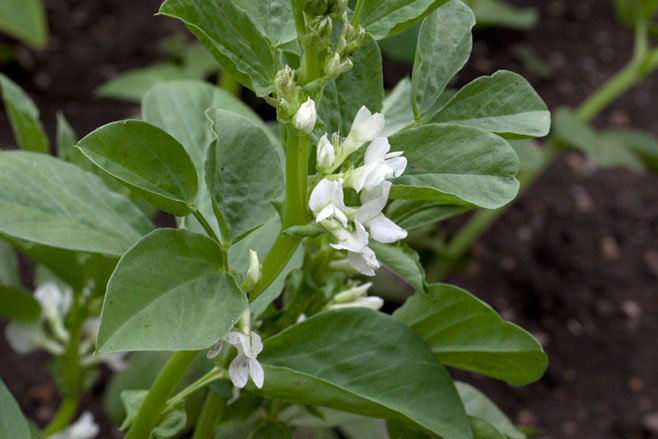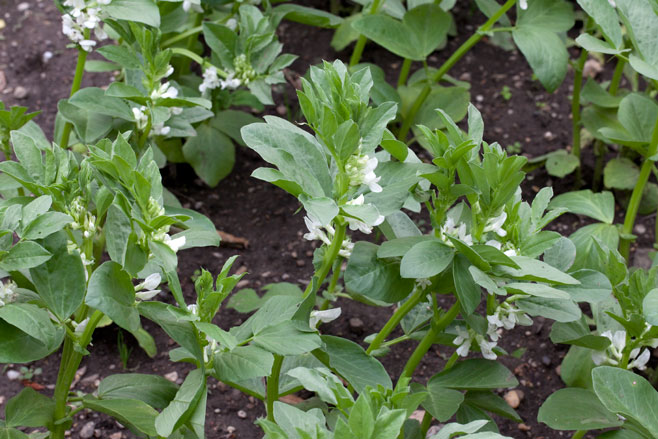|
Vicia faba (Broad Bean, Faba Bean, Horse Bean,
Tic Bean) Life
> eukaryotes >
Archaeoplastida >
Chloroplastida
>
Charophyta > Streptophytina > Plantae (land plants)
> Tracheophyta (vascular plants) > Euphyllophyta > Lignophyta (woody plants)
> Spermatophyta (seed plants) > Angiospermae (flowering
plants) > Eudicotyledons > Core Eudicots > Rosids >
Eurosid I > Fabales > Family: Fabaceae > Subfamily: Papilionoideae
> Genus: Vicia
 |
 |
|
Vicia faba, Vienna Botanical Gardens,
Austrtia. [photos
H.G.
Robertson, Iziko ©] |
Bean seeds and very young pods are eaten as a vegetable.
Seeds have a high protein content of about 20-25%. Broad Bean was probably
domesticated in the eastern Mediterranean region in the late Neolithic (about
6800- 4500 BC) but precise evidence is lacking and in addition we have no
idea of the wild plant species from which it was derived.
No one has yet discovered the wild species from which Vicia
faba is derived. All the species of Vicia discovered that are in the
same group as Vicia faba (section Faba of the genus Vicia),
have a diploid chromosome number (2n) of 14 whereas Vicia faba has
12 chromosomes and cannot be crossed with known wild species. This means that
either the wild species has not yet been discovered or that it has gone extinct.
Domestication of Broad Bean probably occurred in the
eastern Mediterranean region but exactly when and where remains a mystery.
Remains of seeds have been found in an archaeological excavation near Nazareth
in north Israel dating to 6800-6500 BC but these are small and could have been
from wild plants. No other Neolithic farming village excavations (i.e. farming
villages in the near East dating back further than about 4500 BC) have revealed
further remains. Numerous remains of Vicia faba suddently start appearing
in archaeological excavations in the Mediterranean basin and central Europe
dating to the 3rd millenium BC.
Present day varieties of Broan Bean can be divided into
four main groups (Phillips & Rix 1993):
-
Broad Bean (var. faba or major).
Eaten as a vegetable. Grouped into varieties with long pods (up to 8 seeds
per pod) and those with short pods ('Windsor') which have about 4 seeds per
pod.
-
Horse Bean (var. equina). Grown for
animal feed.
-
Tic Bean (var. minor); and
-
var. paucijuga. Similar to Tic Bean and
grown in Central Asia. Unlike other varieties, it is mainly
self-pollinating.
The Broad Bean plant has the advantage of being
frost-tolerant so that in Europe it is possible to successfully sow seed in
Autumn yielding plants that are harvested in early summer.
Besides being able to eat the cooked bean seeds, the very
young pods can be eaten whole. Broad Beans are the principal protein source for
poor people in some Asian and Mediterranean countries such as Egypt. Broad Bean
seeds are usually stored dried and are cooked by soaking them in water overnight
and then cooking them for about 1.5 hours (or 40 minutes in pressure cooker).
Fresh bean seeds need only be boiled for 10-15 minutes (Brown 1991) although
some people prefer to cook them longer to make them softer (loose more vitamins
and minerals in the process). The protein content of bean seeds is high,
amounting to about 20-25%.
References
-
Brown, S. (Ed.) 1991. DK Pocket
Encyclopedia - Vegetarian Cookery. Dorling Kindersley, London.
-
Phillips, R. & Rix, M. 1993. Vegetables.
Pan Books, London.
-
Zohary, D. & Hopf, M. 1993. Domestication
of plants in the old World - The origin and spread of cultivated plants in
West Asia, Europe, and the Nile Valley. Clarendon Press, Oxford.
Text by Hamish Robertson
|
